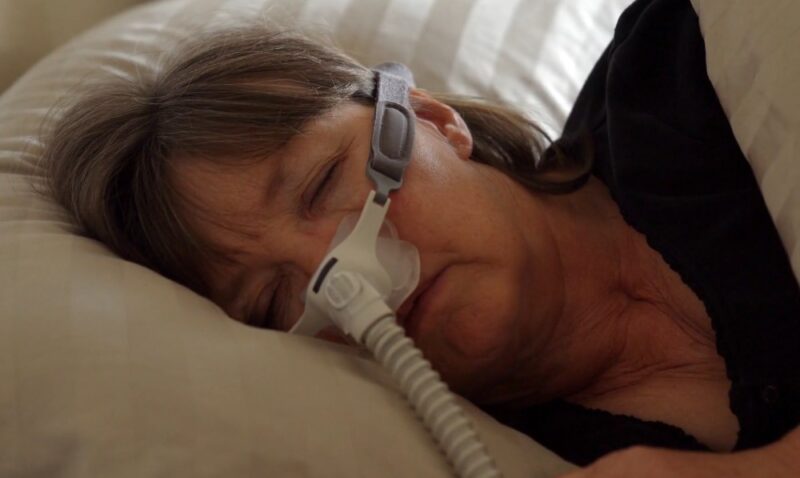Sleep apnea is a significant and potentially life-threatening sleep disorder characterized by repeated interruptions in breathing during sleep.
These interruptions often lead to reduced oxygen levels, disrupted sleep, and various associated health issues.
Despite its prevalence, sleep apnea is frequently undiagnosed due to subtle symptoms and limited awareness.
The disorder primarily manifests in two types: obstructive sleep apnea (OSA) and central sleep apnea (CSA). A third type, treatment-emergent central sleep apnea, arises when OSA, under treatment, transitions into a form of CSA.
The most common form of sleep apnea is OSA, wherein the muscles at the back of the throat relax excessively, obstructing airflow.
In CSA, however, the brain does not send proper signals to the muscles controlling breathing, halting the breathing process altogether.
Both conditions demand prompt medical attention, as untreated sleep apnea is linked to severe health complications, including cardiovascular disease, type 2 diabetes, and metabolic syndrome.
Symptoms of Sleep Apnea
The symptoms of OSA and CSA often overlap, making it challenging to diagnose the specific type of sleep apnea without a professional sleep study. However, some common symptoms are consistently associated with both types:
- Loud Snoring: This is often the first noticeable symptom of OSA, although not everyone who snores has sleep apnea.
- Breathing Pauses: A common sign observed by a partner, breathing pauses during sleep can last several seconds, after which the sleeper may gasp, snort, or choke.
- Gasping or Choking: This usually follows a breathing pause, as the sleeper attempts to regain airflow.
- Dry Mouth and Morning Headaches: Waking up with a dry mouth or morning headaches is common, especially in those with OSA.
- Insomnia: Difficulty in maintaining sleep, frequent awakenings, and restlessness during the night are common in both OSA and CSA.
- Daytime Sleepiness: Known as hypersomnia, excessive daytime sleepiness often affects those with sleep apnea, impairing concentration and attention span.
- Mood Disturbances: Sleep apnea is linked to irritability, mood swings, and in some cases, symptoms of depression.
Causes of Sleep Apnea
1. Obstructive Sleep Apnea (OSA)
OSA occurs when the muscles in the back of the throat, including those supporting the soft palate and the uvula, relax excessively during sleep.
This collapse leads to a narrowed or closed airway, temporarily halting airflow as it is stated by NCBI.
The drop in blood oxygen levels triggers the brain to momentarily awaken the individual, typically accompanied by a gasping, snorting, or choking sound as they reopen their airway.
This cycle can repeat dozens or even hundreds of times per night, fragmenting sleep and preventing the individual from reaching deeper, more restorative sleep stages.
2. Central Sleep Apnea (CSA)
CSA is a less common form of sleep apnea caused by an interruption in the brain’s signaling to the muscles that control breathing.
In CSA, no effort is made to breathe for brief periods, leading to frequent awakenings and, in some cases, shortness of breath.
Individuals with CSA may find it challenging to initiate or maintain sleep and are prone to restless, fragmented sleep patterns according to an NCBI study.
Risk Factors for Sleep Apnea

Sleep apnea can affect anyone, regardless of age or gender, although certain factors elevate the risk for developing either OSA or CSA.
Obstructive Sleep Apnea (OSA) Risk Factors
Excess Weight
Obesity is one of the most significant risk factors for OSA.
Fat deposits around the neck and throat can obstruct breathing, increasing the likelihood of airway collapse during sleep.
Neck Circumference
People with thicker necks may have narrower airways, increasing the risk of OSA.
Anatomical Characteristics
Inherited physical traits, such as a narrow throat, enlarged tonsils, or adenoids, can restrict airflow and contribute to OSA, particularly in children as it is shown in this study.
Gender
Men are at a higher risk of developing OSA compared to women, though post-menopausal women or women with obesity have an increased risk as well.
Age

OSA is more prevalent among older adults, with the risk increasing as individuals age.
Family History
A family history of OSA can predispose individuals to the disorder, suggesting a possible genetic component.
Alcohol and Sedatives
These substances relax throat muscles, worsening OSA symptoms.
Smoking

Smokers are three times more likely to have OSA than nonsmokers. Smoking can cause inflammation and fluid retention in the upper airway, which can obstruct breathing.
Nasal Congestion
Difficulty breathing through the nose, whether due to anatomical issues or allergies, increases the risk of OSA.
Medical Conditions
Chronic illnesses, including hypertension, type 2 diabetes, congestive heart failure, polycystic ovary syndrome, and hormonal disorders, are associated with a heightened risk of OSA.
Central Sleep Apnea (CSA) Risk Factors
- Age: Middle-aged and older individuals have a higher risk of CSA, with the prevalence increasing with age.
- Gender: Similar to OSA, men are more likely to develop CSA than women.
- Heart Disorders: Congestive heart failure and other cardiovascular issues can increase the likelihood of CSA.
- Narcotic Pain Medications: Long-term opioid use, particularly with long-acting drugs such as methadone, raises the risk of CSA.
- Stroke: Individuals who have experienced a stroke are at a greater risk of developing CSA.
Complications

Sleep apnea poses a range of serious health complications that extend beyond poor sleep quality.
Daytime Fatigue and Cognitive Impairment
NCBI studies have shown that the repeated sleep interruptions caused by sleep apnea prevent individuals from reaching the restorative stages of sleep, resulting in persistent daytime fatigue and cognitive issues.
Individuals may experience poor concentration, memory difficulties, and an increased likelihood of workplace or motor vehicle accidents.
Cardiovascular Problems
The sudden drops in blood oxygen levels associated with OSA strain the cardiovascular system, often leading to elevated blood pressure (hypertension).
Marcella Rivas research has established that untreated OSA raises the risk of heart attack, stroke, and irregular heartbeats, including atrial fibrillation.
In individuals with preexisting heart disease, severe episodes of low blood oxygen (hypoxia or hypoxemia) can precipitate sudden cardiac death due to arrhythmias.
Type 2 Diabetes and Metabolic Syndrome
Sleep apnea is associated with insulin resistance, which can lead to type 2 diabetes.
Additionally, OSA is closely linked to metabolic syndrome—a collection of health conditions, including hypertension, abnormal cholesterol levels, elevated blood glucose, and increased waist circumference, that collectively raise the risk of cardiovascular disease.
Complications with Surgery and Medications
People with sleep apnea, particularly OSA, are at a higher risk for complications when undergoing surgery, especially when under anesthesia.
The relaxed state induced by anesthesia compounds breathing difficulties, raising the likelihood of postoperative complications.
Liver Dysfunction

Sleep apnea is correlated with abnormal liver function tests and an increased risk of nonalcoholic fatty liver disease.
These liver complications likely stem from the repetitive drops in blood oxygen levels and the associated systemic inflammation.
Impact on Relationships
The loud snoring and gasping sounds associated with OSA can disrupt the sleep of partners, resulting in sleep-deprived households. It is not uncommon for partners to sleep in separate rooms to avoid being woken up throughout the night. Also, if you are looking for sleeping aids, use natural ones.
Complications Specific to Central Sleep Apnea (CSA)
Abdul Wahab notes that CSA shares some complications with OSA, such as cardiovascular issues and excessive fatigue, it may worsen the prognosis in individuals with heart disease due to repeated oxygen deprivation episodes.
The lack of regular breathing patterns can lead to decreased blood oxygen levels, potentially aggravating underlying cardiovascular conditions.
Conclusion
Sleep apnea, although a common sleep disorder, can have severe consequences if left untreated. Its symptoms, particularly those of obstructive sleep apnea, are often subtle and may be dismissed as simple snoring or fatigue.
However, both OSA and CSA significantly impact an individual’s quality of life, leading to chronic fatigue, mood disturbances, and a heightened risk for various health conditions, including cardiovascular disease, type 2 diabetes, and liver disease.
References:
- Slowik JM, Sankari A, Collen JF. Obstructive Sleep Apnea. [Updated 2024 Mar 21]. In: StatPearls [Internet]. Treasure Island (FL): StatPearls Publishing; 2024 Jan-. Available from: https://www.ncbi.nlm.nih.gov/books/NBK459252/
-
Rana AM, Sankari A. Central Sleep Apnea. [Updated 2023 Jun 11]. In: StatPearls [Internet]. Treasure Island (FL): StatPearls Publishing; 2024 Jan-. Available from: https://www.ncbi.nlm.nih.gov/books/NBK578199/
-
Jehan S, Zizi F, Pandi-Perumal SR, Wall S, Auguste E, Myers AK, Jean-Louis G, McFarlane SI. Obstructive Sleep Apnea and Obesity: Implications for Public Health. Sleep Med Disord. 2017;1(4):00019. Epub 2017 Dec 12. PMID: 29517065; PMCID: PMC5836788.
-
InformedHealth.org [Internet]. Cologne, Germany: Institute for Quality and Efficiency in Health Care (IQWiG); 2006-. Overview: Enlarged tonsils and adenoids. [Updated 2023 Jan 17]. Available from: https://www.ncbi.nlm.nih.gov/books/NBK536881/
-
Benkirane O, Delwiche B, Mairesse O, Peigneux P. Impact of Sleep Fragmentation on Cognition and Fatigue. Int J Environ Res Public Health. 2022 Nov 22;19(23):15485. doi: 10.3390/ijerph192315485. PMID: 36497559; PMCID: PMC9740245.
-
Rivas M, Ratra A, Nugent K. Obstructive sleep apnea and its effects on cardiovascular diseases: a narrative review. Anatol J Cardiol. 2015 Nov;15(11):944-50. doi: 10.5152/AnatolJCardiol.2015.6607. PMID: 26574763; PMCID: PMC5336948.
-
Wahab A, Chowdhury A, Jain NK, Surani S, Mushtaq H, Khedr A, Mir M, Jama AB, Rauf I, Jain S, Korsapati AR, Chandramouli MS, Boike S, Attallah N, Hassan E, Chand M, Bawaadam HS, Khan SA. Cardiovascular Complications of Obstructive Sleep Apnea in the Intensive Care Unit and Beyond. Medicina (Kaunas). 2022 Oct 3;58(10):1390. doi: 10.3390/medicina58101390. PMID: 36295551; PMCID: PMC9609939.















